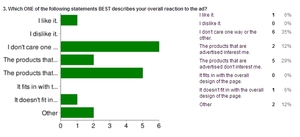Last week I experimented with putting the following ad on the front right hand page of my web site:
Given the low traffic of my site I had no real expectation of making any money from clicks on this ad that led to sales. Rather, I was interested in what people might think about the appearance of the ad. I constantly tinker with the appearance of my web site. What to do with the “real estate” I’ve opened up on the right hand side of my now 3-column site is something I’m pondering.
Accordingly, I prepared a little three-question survey and announced it in Linkedin Bloggers, a 897-member netorking group I moderate and in Twitter, where I currently have about 935 “followers.”
I received a total of 18 survey responses as of 6 am ET on December 15. A brief summary of these responses, collected and displayed via the Google Docs “Forms” feature, is below. Click on an image to see a readable version of the response summary. (Although I have removed the ad from the right hand column of my web page, you can still answer the survey questions by clicking here).
Question 1: “Can You See the Ad?”
I asked this question since, because of the ad blocking software I run on my Firefox browser, I often do not see ads on web pages I visit. If others are doing the same, what’s the point of displaying ads on my own site?
Sixteen of the 18 respondents reported that they could see the ad. Two people reported they could not see the ad. One responded, “For whatever reason I can no longer see ads on my own blogs, b5’s, other blogs or yours. I’ve blocked nothing and use both FF and NS 7.2.”
Do I care that only 2 out of 18 people couldn’t see the ad? For me, yes. My web site is pretty specialized and is by no means a “high volume” web site. I value each reader. So I am not inclined to do something that I know is going to be missed by even a small number of readers.
Question 2: “Have you clicked on the ad and looked at the web site of the company that sponsors it?”
While this ad has no explicit instruction or call to action, it does have the name “Spacetoys” prominently displayed, so I don’t think it is likely that it will not be recognized as an ad. My question was whether or not anyone would actually be interested in clicking to check it out.
Four of the 18 said they would actually click on it, while 12 said they probably would not.
Four out of 18 sounds like a high percentage to me. My conclusion is that, for this ad at least, a fairly significant number of visitors to my web site might actually click on this link (which would take them away from my web site, obviously).
Question 3: “Which ONE of the following statements BEST describes your overall reaction to the ad?”
This question interested me the most. I usually ignore ads myself unless they are directly relevant to an interest of mine. I also have a viscerally negative reaction to ads that artificially try to attract attention via animation, sound, or video, which is why I use ad blocking software. This Spacetoys ad, even though it deals with a topic I have loved since I was a kid, does cycle through a series of images, so I was curious about the reaction.
It turns out that 6 of the 18 respondents “… don’t care one way or the other” and another 5 say “… the products that are advertised don’t interest me.” No one responded “I don’t like it.” One said it ” … doesn’t fit in with the overall design of the page” and one said “I hate rotating images - too distracting!”
It’s those last two that concern me the most. Again, in a low volume web site, every visitor counts. Why turn people off?
Conclusions
Having been a developer and manager of professionally conducted statistical surveys in a former life, I realize there are some methodological holes in this survey you can drive a truck through, for example:
- Self selection bias.
- Unknown probability of selection.
- Question 3 addresses multiple concepts and should have been a series of questions.
- Questions were not pretested to evaluate possible misinterpretations and sources of bias.
- I made no attempt (say, via Google Analytics) to track actual vs. reported behavior.
- I made no attenpt to gather descriptive data about visitors.
Still, I learned something about some of the people who visit my web site. Most don’t really care one way or the other about this type of advertising, yet there is a small number that react negatively. Since my primary goal with this web site is to promote my professional, research, and consulting interests, not to make money from click-through ads, I pay attention to both the former and the latter group.
Copyright (c) 2008 by Dennis D. McDonald




